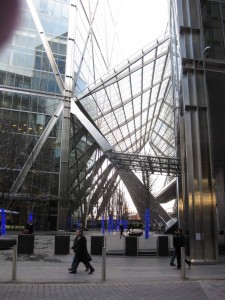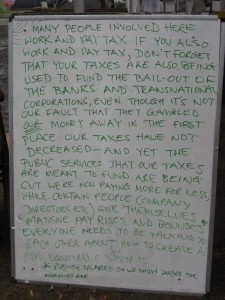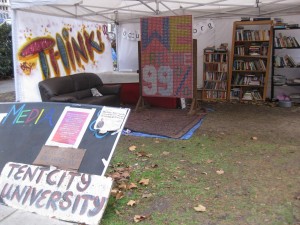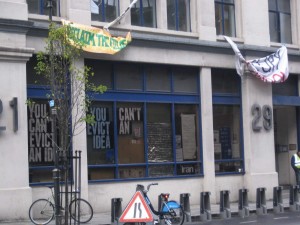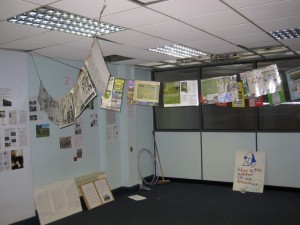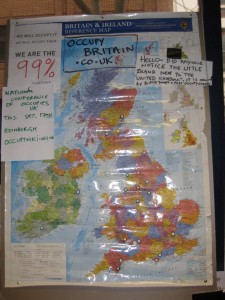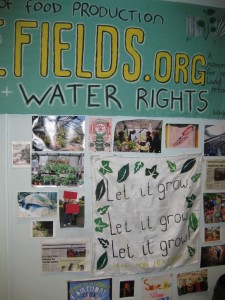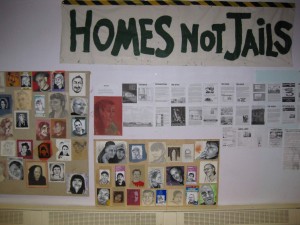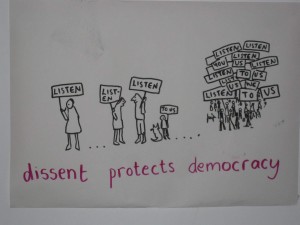You can’t evict an idea – Finsbury Square and the Bank of Ideas
21 Wednesday Dec 2011
Written by Occupy Sheffield in OccupyLondon
Rose Ardron recently visited Occupy London and wrote the following report about her visit. Her last article was about visiting Occupy Wall Street in November, From Burngreave to Wall Street and back again.
Emerging from Moorgate tube station is like landing on another planet. My memories of the city go back to school visits to St Paul’s Cathedral. I wasn’t prepared for this environment of competing angled shapes jostling with each other for space along the polished pavements and into the skyline. It was like landing on another planet where the atmosphere is dominated by power and money as expressed in futuristic physical forms sprinkled with faceless outlets from Starbucks, Prêt a Manger, Gap – the corporate high street. The pavements are full of young suits in a hurry and the streets serviced by taxis and motorbike couriers.
It doesn’t take long to arrive at Finsbury Square. It’s heartening to see the now familiar landscape of pop up tents and tarpaulins. A handwritten white board declares:
“Many people involved here work and pay tax. If you also work and pay tax, don’t forget that your taxes are also being used to fund the bailout of the banks and transnational corporations even though its not our fault that they gambled our money away in the first place. Our taxes have not decreased – and yet the public services that our taxes are meant to fund are being cut. We are now paying more for less, while certain people (company directors etc) give themselves massive pay rises and bonuses* Everyone needs to be talking to each other about how to create a more equitable society.*Publish salaries so we know where the ..”
The young man at the info tent hands me a copy of the Occupied London Times. I ask him how it’s going and we start to chat, agreeing that the camp is there to raise the issues, to get people to think, to talk and to question. This is no mean feat to sustain this in the winter weather. It takes the physical presence to do this – even if it can’t be measured and displayed. I say that I’m from Sheffield and tell him a bit about our camp.
The camp is well defined within the square and there is little sign of activity. The Tent City University is empty – waiting for the next event to take place. The kitchen tent is impressively large. The daily life of the City seems to flow by unaffected by the presence of the camp. The Info Tent and the Tent City University are wide and open to the street – it would be hard to pass by without picking up the message and it’s easy to stop and engage – there’s information and creative messages on display and there’s the newspaper to help start the conversation.
The Bank of Ideas is a few minutes down the street. The banners on the front of the building are beginning to tatter. The guy on the door says they are anticipating eviction. He didn’t want to be specific but said they were planning to open more branches in the future! It’s warm inside the Bank. The schedule board shows that most activities happen later in the day. There is a mid day general Assembly mostly concerned with the running of the building. There is space – rooms on 3 floors and walls covered with displays, information and slogans. There is a welcoming info room and a large space with computers, tea, coffee and folks hanging out. Upstairs a big sleeping space, kitchen and the beginnings of a library. People in twos and threes – often on the stairs – in discussion.
I talk to the guy at the info desk and say how great it would be to have a Bank of Ideas in Sheffield. He comments how little media coverage there seems to be of the camps all over Britain. The note added to the top right of the map says: “Hello – did anyone notice the little island next to ‘The United Kingdom’. It has been occupied by British troops…”
Having a building is an opportunity to generate creativity, explore the issues and make connections:
I didn’t arrive at either place at a point where there was a lot of visible activity, the dynamism was not on the surface. It’s a point of consolidation, embedding and persistence, preparation for eviction and moving forward, fortitude in the face of the cold. Endurance that underpins the high spots – Jesse Jackson had been at St Pauls the day before. Sustaining momentum.

